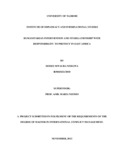| dc.description.abstract | Humanitarian intervention lies at the fault‐line in international relations between the principles of international law and state sovereignty on the one hand, and morality and the protection of human rights on the other. Whereas the former international‐society theory defines humanitarian intervention as a violation of the cardinal rules of order, it is being challenged by the latter view that seeks to strengthen the legitimacy of the international community by developing its commitment to justice. As a result, a solidarist international community is one in which states accept a moral responsibility to protect the security, not only of their own citizens, but of humanity everywhere.
This study explores the emergence of the doctrine of responsibility to protect (R2P) outlining the circumstances that warranted the emergence. It dissects the two R2Ps which are the International Commission on Intervention and State Sovereignty (ICISS) R2P and the United Nations (UN) secretary general Ban Ki-Moon. The first part of the study gives a background of the doctrine of responsibility to protect, giving its elements as outlined in the ICISS report. The legal framework humanitarian intervention and a further presentation of the demise of humanitarian intervention and the emergence of the doctrine of R2P are done in this part.
In the second part a presentation of interventions as an emerging norm is given, giving the normative status of the doctrine of R2P and humanitarian intervention. In the third part, the position of the international community on the doctrine of R2P is given, in the fourth part of the paper, a further exploration of the demise of humanitarian intervention and the emergence of the doctrine of R2P is outlined. The final bit of the study is an examination of international discourse on the doctrine of R2P where the divide on the opinions of the international community on the doctrine of R2P are presented. | en |

